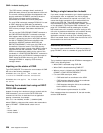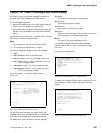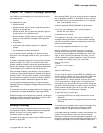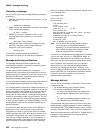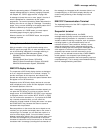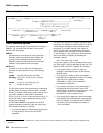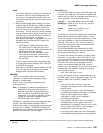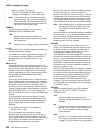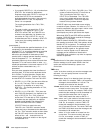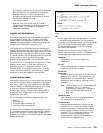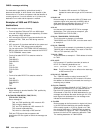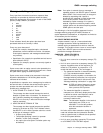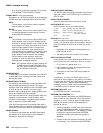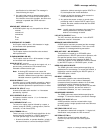CMSG—message switching
| date. For example, if you specify
| FULLDATE=07/29/1998 and TIME=1130, the
| message is transmitted at 11.30 on 07/29/1998.
| Note: In all cases, the delivery time that you request
| must be less than 100 hours from the beginning
| of the current day. This means that the delivery
| time can never be later than 03.59 on the fourth
| day from the current system
1
date.
HEADING
specifies heading information. You can use H or
HEADING in place of HEADING=YES.
YES
Specifies that the current time, date, and
identifier of the originating terminal is to precede
the message text.
NO
causes a previous heading request to be ignored.
ID=(
title
)
title
specifies the title (maximum length 62 characters) to
be associated with the message.
See Chapter 22, “CSPG—page retrieval” on page 253
for commands to request a display of the titles of all
messages queued for immediate delivery to that
terminal.
MSG=message
“message” is the text of the message to be sent. The
keyword MSG and the equal sign are optional. You must
enclose the text within single quotation marks. A single
quotation mark to be included as part of the message
must be represented by a pair of single quotation marks.
The message may be continued across multiple
consecutive inputs.
If the ending single quotation mark is omitted, the entire
input is treated as part of the message and a request to
continue the message is sent to the terminal. The entire
transaction may be canceled, or alternatively, options
previously entered for this transaction may be saved by
entering a single quotation mark followed by a comma to
terminate the MSG option. The correct message can
then be reentered; the previous incorrect message being
ignored.
A single quotation mark at the end of data in a MSG
option means either the end of the MSG option, or the
first of a pair of single quotation marks indicating that a
single quotation mark is to be included as part of the
message.
In this situation, the response to the terminal is:
CONTINUE INPUT OR MSG
If the first character of the next input is a single
quotation mark, it is treated as the second of a pair of
single quotation marks and the message is continued.
Any character other than a single quotation mark causes
the message to be complete, and that character is
treated as the first character of a new option.
New-line (NL) characters within the message are kept.
(If the first character is a new-line character, it is
deleted.) This allows the operator to enter M=' and then
carriage return (CR) or the equivalent of CR, to begin
entering the message text at the left margin. The first
CR is deleted. Additional CRs may be entered if blank
lines are desired at the top of the transmitted message.
Note: If the HEADING option is specified, these blank
lines appear between the heading (time, date,
and originator’s terminal identifier) and the
message.
With NL processing, the delivered message is positioned
at the left margin. If an unformatted message, or a line
within a formatted message, exceeds the line width
defined for the receiving terminal, sentences are split
between words for any line exceeded.
OPCLASS
One or more numbers, each of which can be in the
range 1–24, that define the operator classes that must
be signed on before a message can be delivered. If
more than one number is specified, the list must be
enclosed within parentheses. For example,
OPCLASS=(8,2) causes the message to be sent to all
terminals that currently have an operator of class 8 or 2
signed on, and to all terminals that have that operator
security value specified in their installed definitions. If
OPCLASS=1 is specified, the message is routed to all
terminals that are in service, regardless of whether an
operator is signed on or not.
If ROUTE is specified as well, the message is routed to
all requested destinations, but is not eligible for delivery
to a terminal unless the class of the operator signed on
matches one of the numbers specified by OPCLASS.
However, if a ROUTE destination is qualified by an
operator identifier, OPCLASS is ignored for that
destination. For more information about how ROUTE=
and OPCLASS= are used together, see the description
of the ROUTE option.
PROTECT
specifies message recovery for a CICS emergency
restart. You can use P or PROTECT in place of
PROTECT=YES.
YES
Specifies that $$ is to be prefixed to the
temporary storage data identifier of the stored
message.
NO
Specifies that a previous protect request is to be
ignored. This is done by using the default prefix
of **. The same method is used to omit the
option altogether.
prefix
Specifies a 1-or 2-character prefix to be used for
the temporary-storage data identifier of the stored
message. If a single character only is specified, a
236 CICS Supplied Transactions



